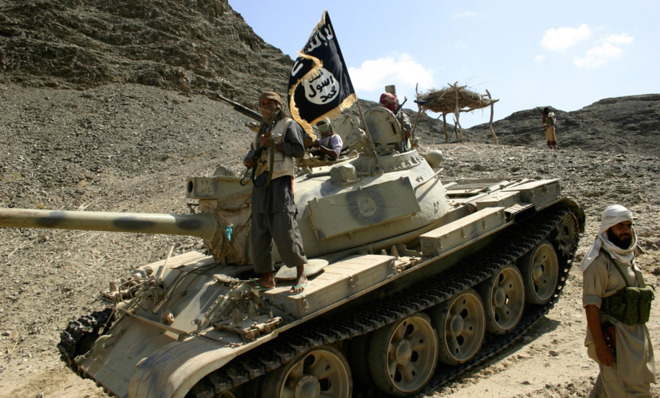No, al Qaeda is not more dangerous now than before 9/11
But the NSA would certainly like you to think that

It's been more than 12 years since al Qaeda launched its devastating attack on the U.S., killing almost 3,000 people and changing the course of American history. And despite a host of ensuing counterterrorism efforts to debilitate al Qaeda, including the killing of Osama bin Laden, some are now claiming that the terrorist network is stronger than ever.
On Nov. 15, House Intelligence Committee Chairman Mike Rogers (R-Mich.) — a champion of NSA surveillance — told CNN that al Qaeda "poses a bigger threat to attack inside the U.S. right now than it did before 9/11." That assertion came a day after National Journal reported that "the death of bin Laden...[has] set the stage for a rebirth of al Qaeda as a global threat."
So is it time to hit the giant red panic button? Not exactly. Counterterrorism experts tell The Week that the terrorist organization is crippled and is unlikely to launch a wide-scale attack inside the United States, focusing instead on diverse targets abroad.
The Week
Escape your echo chamber. Get the facts behind the news, plus analysis from multiple perspectives.

Sign up for The Week's Free Newsletters
From our morning news briefing to a weekly Good News Newsletter, get the best of The Week delivered directly to your inbox.
From our morning news briefing to a weekly Good News Newsletter, get the best of The Week delivered directly to your inbox.
"Al Qaeda central no longer exists as an effective organization," says Fawaz Gerges, a professor at the London School of Economics and Political Science, who has done extensive field research on al Qaeda. "Most of its skilled leaders and lieutenants have been either killed or captured. It is no longer capable of carrying out spectacular operations along the 9/11 lines."
In the last ten years, al Qaeda has come to resemble a wounded hydra-headed snake. Steven Weber, a political science professor at the University of California at Berkeley, says, "Everybody agrees that the United States has done a pretty good job of chopping off the heads of the organization."
For example, the guy that the National Journal calls "the next bin Laden," Abu Musab al-Suri, "hasn't been heard from in years [and] it's hard to lead a top terrorist organization if you're dead or in prison," says Aki Peritz, a senior policy adviser for Third Way and a former CIA counterterrorism analyst.
Today, the new al Qaeda is made up of smaller, splintered "heads" that have popped up across the globe. There are at least five distinct branches that have sworn allegiance, or "bayat," to al Qaeda, located in Iraq, Yemen, Somalia, North Africa, and Syria. There are also jihadist organizations that cooperate with al Qaeda, but haven't actually sworn allegiance to the terrorist group. And finally, there are "sympathizers" like the Fort Hood shooter, who are inspired by al Qaeda, but have no tangible connection with the group.
A free daily email with the biggest news stories of the day – and the best features from TheWeek.com
Prior to 9/11, al Qaeda was so organized that members had vacation days. That's not the case anymore.
On the surface, the proliferation of these distinct groups certainly sounds scary. Rep. Rogers makes the case that the new factions make al Qaeda's capabilities "more dangerous and more numerous" to the U.S. homeland.
But counterterrorism experts disagree. "Since al Qaeda has become more decentralized, the vast majority of attacks are happening against what you'd call the 'near-enemy,' so for example, attacks by al Shabab are focused almost entirely on inside of Somalia," says Seth Jones, an associate director for the RAND Corporation. "They're not more dangerous, if what concerns you most is attacks on the homeland."
Director of National Intelligence James Clapper concurs. "Senior personnel losses in 2012, amplifying losses and setbacks since 2008, have degraded core al Qaeda to a point that the group is probably unable to carry out complex, large-scale attacks in the West," he wrote in a March 2013 threat assessment.
One threat that is legitimate, according to Jones and Clapper, is against U.S. diplomatic targets abroad, such as American embassies. But those attacks are still less numerous than they were 20 years ago. According to U.S. State Department data collected by Mother Jones, attacks against U.S. diplomatic targets peaked at over 30 attacks per year in the 1990s — but in 2010, there were less than five.
The NSA naturally credits its advanced surveillance system with the drop in attacks. But experts aren't convinced. According to the Huffington Post, the NSA "has been inconsistent on how many plots it has helped prevent and what role the surveillance programs played." And one of the big examples it did make public — the arrest of Najibullah Zazi in 2009, for a plot to plant bombs in the New York subway system — appears to have been prevented by British intelligence, not the NSA, according to the Associated Press.
"I think there is a need to collect intelligence overseas, against groups that are plotting attacks against U.S. embassies, that's reasonable," says Jones. "But that decrease on attacks in the U.S. homeland means that we've got to be careful on what we're collecting on U.S. citizens."
Weber from UC Berkeley adds, "There's nothing worse in a democratic conversation than to have people in authority say, 'If you knew what I knew, you'd agree with me.' Do you take them on faith or not? How the hell do you know?"
Dana Liebelson is a reporter for Mother Jones. A graduate of George Washington University, she has worked for a variety of advocacy organizations in the District, including the Project on Government Oversight, International Center for Journalists, Rethink Media, the Reporters Committee for Freedom of the Press, and Change.org. She speaks Mandarin and German and plays violin in the D.C.-based Indie rock band Bellflur.
-
 All roads to Ukraine-Russia peace run through Donetsk
All roads to Ukraine-Russia peace run through DonetskIN THE SPOTLIGHT Volodymyr Zelenskyy is floating a major concession on one of the thorniest issues in the complex negotiations between Ukraine and Russia
-
 Why is Trump killing off clean energy?
Why is Trump killing off clean energy?Today's Big Question President halts offshore wind farm construction
-
 8 restaurants that are exactly what you need this winter
8 restaurants that are exactly what you need this winterThe Week Recommends Old standards and exciting newcomers alike